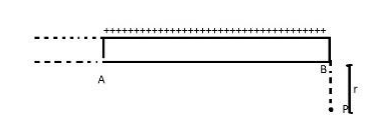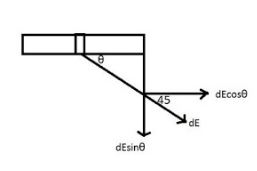
A semi-infinite insulating rod has linear charge density $ \lambda $ . The electric field at the point P shown in figure is :-

(A) $ \dfrac{{2{\lambda ^2}}}{{{{\left( {4\pi {\varepsilon _0}r} \right)}^2}}} $ at $ {45^ \circ } $ with AB
(B) $ \dfrac{{\sqrt 2 \lambda }}{{\left( {4\pi {\varepsilon _0}{r^2}} \right)}} $ at $ {45^ \circ } $ with AB
(C) $ \dfrac{{\sqrt 2 \lambda }}{{\left( {4\pi {\varepsilon _0}r} \right)}} $ at $ {45^ \circ } $ with AB
(D) $ \dfrac{{\sqrt 2 \lambda }}{{\left( {4\pi {\varepsilon _0}r} \right)}} $ at perpendicular with AB

Answer
548.4k+ views
Hint: We will calculate the x-component and the y-component of the electric field at the point P, as shown in the figure, due to the semi-infinite insulating rod carrying uniform linear charge of density $ \lambda $ .We integrate the electric field $ d{E_x} $ over the length of the “semi-infinite” rod that is with respect to the variable $ x $ from 0 to $ \infty $ .
Complete step by step answer:
It has been given that a semi-infinite insulating rod has linear charge density $ \lambda $ .

Consider an infinitesimal charge element of length $ dx $ at distance $ x $ from the end of the rod as shown in the figure.
$ \cos \theta = \dfrac{x}{{\sqrt {{r^2} + {x^2}} }} $ by Pythagoras Theorem, which states that the square of the hypotenuse is equal to the square of the other two sides of a right angled-triangle.
As the direction of electric field due to a charge element is along the line joining the element to the point where the field is to be calculated.
From the figure, the x-component of the field will be,
$ d{E_x} = dE\cos \theta $
$ \Rightarrow d{E_x} = \dfrac{{\lambda dx}}{{\left( {{r^2} + {x^2}} \right)}} \times \dfrac{x}{{\sqrt {{r^2} + {x^2}} }} $
Integrating $ d{E_x} $ over the length of the “semi-infinite” rod that is with respect to the variable $ x $ from 0 to $ \infty $ , we get
$ \int {d{E_x}} = k\lambda \int {\dfrac{{xdx}}{{{{\left( {{r^2} + {x^2}} \right)}^{{\raise0.7ex\hbox{ $ 3 $ } \!\mathord{\left/
{\vphantom {3 2}}\right.}
\!\lower0.7ex\hbox{ $ 2 $ }}}}}}} $
For simplicity we take $ t = {r^2} + {x^2} $ .
Thus, $ dxdx = dt $ .
On simplifying the equation, we can get,
$ \int {d{E_x}} = k\lambda \int {\dfrac{{dt}}{{{{\left( t \right)}^{{\raise0.7ex\hbox{ $ 3 $ } \!\mathord{\left/
{\vphantom {3 2}}\right.}
\!\lower0.7ex\hbox{ $ 2 $ }}}}}}} $ .
By rules of integration,
$ \int {dE} = \dfrac{{k\lambda }}{2} \times \dfrac{{ - 3}}{2}{t^{ - {\raise0.7ex\hbox{ $ 1 $ } \!\mathord{\left/
{\vphantom {1 2}}\right.}
\!\lower0.7ex\hbox{ $ 2 $ }}}} $ .
Substituting, the value of $ t = {r^2} + {x^2} $ , and setting limits of integration at 0 and $ \infty $ ,
$ \int {d{E_x}} = k\lambda \left[ {\dfrac{1}{{\sqrt {{r^2} + {x^2}} }}} \right]_0^\infty $
$ \Rightarrow {E_x} = \dfrac{{k\lambda }}{r} $
We note that $ \left| {{E_x}} \right| = \left| {{E_y}} \right| $ for all $ r $ .
Therefore, the angle that the electric field vector makes at P is
$ \tan \theta = \dfrac{{\left| {{E_x}} \right|}}{{\left| {{E_y}} \right|}} $ .
Since $ \left| {{E_x}} \right| = \left| {{E_y}} \right| $ , $ \tan \theta = 1 $ .
It implies that $ \theta = {45^ \circ } $ and is independent of $ r $ , that is the distance of the point P from the edge of the “semi-infinite” rod.
Now, the net electric field is given by, $ {E_{net}} = \sqrt {{E_X}^2 + {E_Y}^2} = \sqrt 2 \dfrac{{k\lambda }}{r} $ where $ k = \dfrac{1}{{4\pi {\varepsilon _0}}} $ is a constant.
Hence the net electric field is $ \dfrac{{\sqrt 2 \lambda }}{{\left( {4\pi {\varepsilon _0}r} \right)}} $ at $ {45^ \circ } $ with AB.
The correct answer is Option C.
Note:
Electric field is defined as the electric force per unit charge. The direction of the field is taken to be the direction of the force it would exert on a positive test charge. The electric field is radially outward from a positive charge and radially in toward a negative point charge.
Complete step by step answer:
It has been given that a semi-infinite insulating rod has linear charge density $ \lambda $ .

Consider an infinitesimal charge element of length $ dx $ at distance $ x $ from the end of the rod as shown in the figure.
$ \cos \theta = \dfrac{x}{{\sqrt {{r^2} + {x^2}} }} $ by Pythagoras Theorem, which states that the square of the hypotenuse is equal to the square of the other two sides of a right angled-triangle.
As the direction of electric field due to a charge element is along the line joining the element to the point where the field is to be calculated.
From the figure, the x-component of the field will be,
$ d{E_x} = dE\cos \theta $
$ \Rightarrow d{E_x} = \dfrac{{\lambda dx}}{{\left( {{r^2} + {x^2}} \right)}} \times \dfrac{x}{{\sqrt {{r^2} + {x^2}} }} $
Integrating $ d{E_x} $ over the length of the “semi-infinite” rod that is with respect to the variable $ x $ from 0 to $ \infty $ , we get
$ \int {d{E_x}} = k\lambda \int {\dfrac{{xdx}}{{{{\left( {{r^2} + {x^2}} \right)}^{{\raise0.7ex\hbox{ $ 3 $ } \!\mathord{\left/
{\vphantom {3 2}}\right.}
\!\lower0.7ex\hbox{ $ 2 $ }}}}}}} $
For simplicity we take $ t = {r^2} + {x^2} $ .
Thus, $ dxdx = dt $ .
On simplifying the equation, we can get,
$ \int {d{E_x}} = k\lambda \int {\dfrac{{dt}}{{{{\left( t \right)}^{{\raise0.7ex\hbox{ $ 3 $ } \!\mathord{\left/
{\vphantom {3 2}}\right.}
\!\lower0.7ex\hbox{ $ 2 $ }}}}}}} $ .
By rules of integration,
$ \int {dE} = \dfrac{{k\lambda }}{2} \times \dfrac{{ - 3}}{2}{t^{ - {\raise0.7ex\hbox{ $ 1 $ } \!\mathord{\left/
{\vphantom {1 2}}\right.}
\!\lower0.7ex\hbox{ $ 2 $ }}}} $ .
Substituting, the value of $ t = {r^2} + {x^2} $ , and setting limits of integration at 0 and $ \infty $ ,
$ \int {d{E_x}} = k\lambda \left[ {\dfrac{1}{{\sqrt {{r^2} + {x^2}} }}} \right]_0^\infty $
$ \Rightarrow {E_x} = \dfrac{{k\lambda }}{r} $
We note that $ \left| {{E_x}} \right| = \left| {{E_y}} \right| $ for all $ r $ .
Therefore, the angle that the electric field vector makes at P is
$ \tan \theta = \dfrac{{\left| {{E_x}} \right|}}{{\left| {{E_y}} \right|}} $ .
Since $ \left| {{E_x}} \right| = \left| {{E_y}} \right| $ , $ \tan \theta = 1 $ .
It implies that $ \theta = {45^ \circ } $ and is independent of $ r $ , that is the distance of the point P from the edge of the “semi-infinite” rod.
Now, the net electric field is given by, $ {E_{net}} = \sqrt {{E_X}^2 + {E_Y}^2} = \sqrt 2 \dfrac{{k\lambda }}{r} $ where $ k = \dfrac{1}{{4\pi {\varepsilon _0}}} $ is a constant.
Hence the net electric field is $ \dfrac{{\sqrt 2 \lambda }}{{\left( {4\pi {\varepsilon _0}r} \right)}} $ at $ {45^ \circ } $ with AB.
The correct answer is Option C.
Note:
Electric field is defined as the electric force per unit charge. The direction of the field is taken to be the direction of the force it would exert on a positive test charge. The electric field is radially outward from a positive charge and radially in toward a negative point charge.
Recently Updated Pages
Master Class 12 English: Engaging Questions & Answers for Success

Master Class 12 Economics: Engaging Questions & Answers for Success

Master Class 12 Social Science: Engaging Questions & Answers for Success

Master Class 12 Maths: Engaging Questions & Answers for Success

Master Class 12 Chemistry: Engaging Questions & Answers for Success

Master Class 12 Business Studies: Engaging Questions & Answers for Success

Trending doubts
What are the major means of transport Explain each class 12 social science CBSE

Which are the Top 10 Largest Countries of the World?

Draw a labelled sketch of the human eye class 12 physics CBSE

Explain sex determination in humans with line diag class 12 biology CBSE

The pH of the pancreatic juice is A 64 B 86 C 120 D class 12 biology CBSE

Explain sex determination in humans with the help of class 12 biology CBSE




